International Finance Report: Offshore Financial Centers Analysis
VerifiedAdded on 2022/08/24
|7
|815
|24
Report
AI Summary
This report delves into the realm of international finance, focusing on the significance of offshore financial centers (OFCs) in contemporary capitalism. It explores the role of OFCs in allowing private investors and corporations to bypass taxation and regulations, citing Zucman's evaluation of trillions of dollars in private assets registered in OFCs. The report examines the impact of OFCs on the global financial crisis and the subsequent regulations imposed by the G20 summit. It then discusses the measurement of OFCs, including foreign bank deposits, foreign direct investment, foreign portfolio investment, and the offshore intensity ratio. The report provides insights into the position of OFCs in global finance, supported by graphical representations and data on cross-border financial relationships. The conclusion emphasizes the use of the offshore intensity ratio to identify OFCs and the impact of strict regulations on offshore jurisdictions. References to relevant academic studies are included.
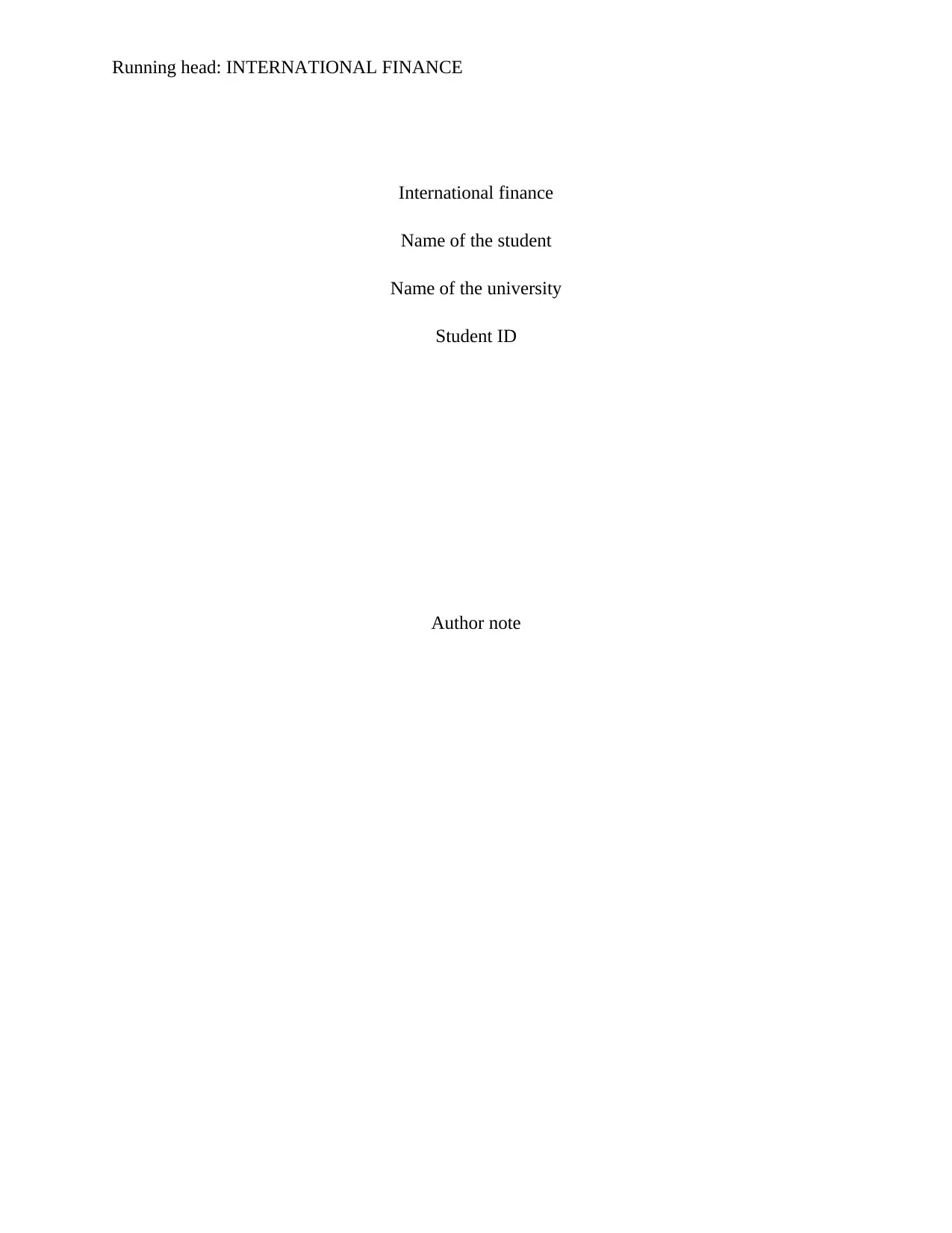
Running head: INTERNATIONAL FINANCE
International finance
Name of the student
Name of the university
Student ID
Author note
International finance
Name of the student
Name of the university
Student ID
Author note
Paraphrase This Document
Need a fresh take? Get an instant paraphrase of this document with our AI Paraphraser
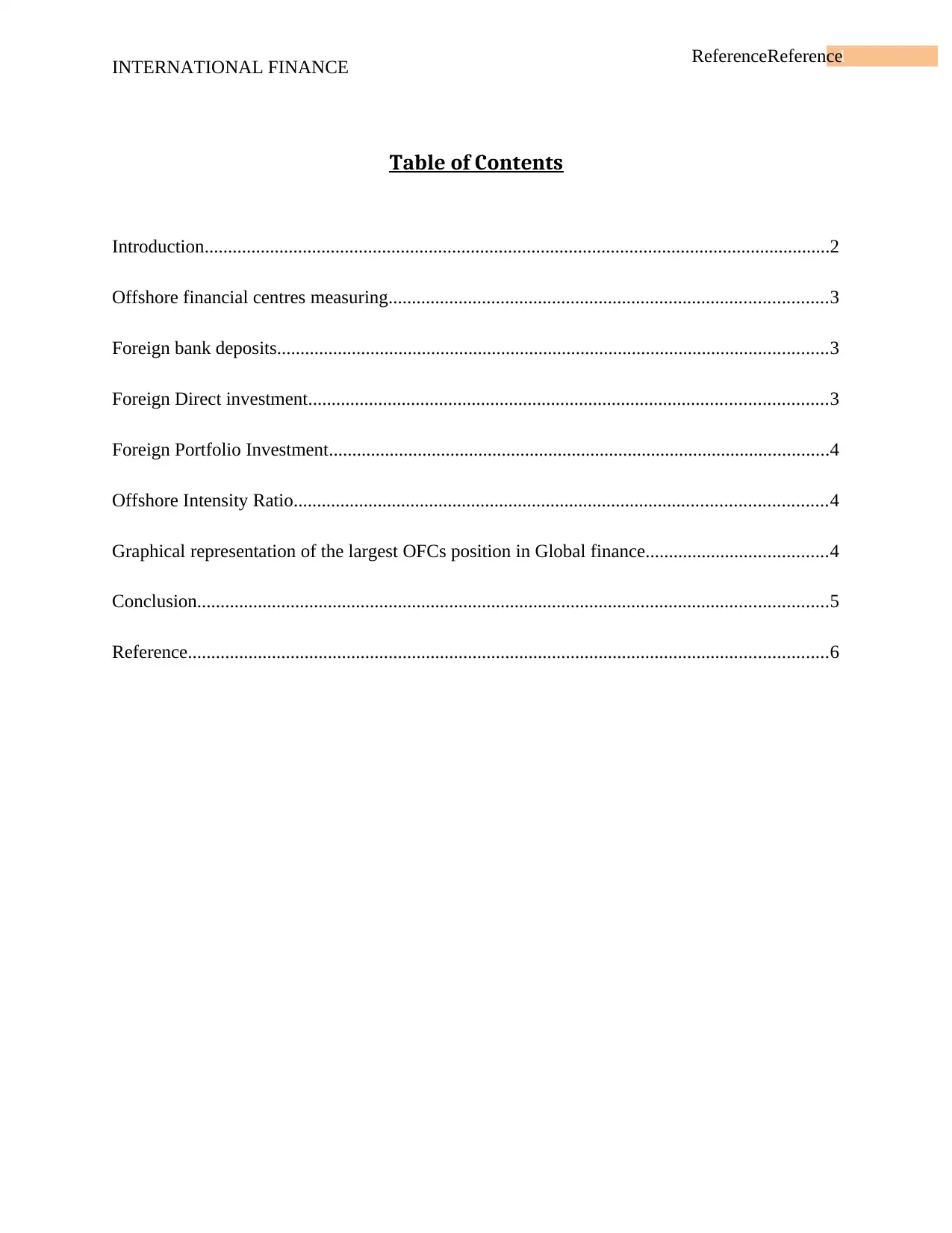
1ReferenceReference
INTERNATIONAL FINANCE
Table of Contents
Introduction......................................................................................................................................2
Offshore financial centres measuring..............................................................................................3
Foreign bank deposits......................................................................................................................3
Foreign Direct investment...............................................................................................................3
Foreign Portfolio Investment...........................................................................................................4
Offshore Intensity Ratio..................................................................................................................4
Graphical representation of the largest OFCs position in Global finance.......................................4
Conclusion.......................................................................................................................................5
Reference.........................................................................................................................................6
INTERNATIONAL FINANCE
Table of Contents
Introduction......................................................................................................................................2
Offshore financial centres measuring..............................................................................................3
Foreign bank deposits......................................................................................................................3
Foreign Direct investment...............................................................................................................3
Foreign Portfolio Investment...........................................................................................................4
Offshore Intensity Ratio..................................................................................................................4
Graphical representation of the largest OFCs position in Global finance.......................................4
Conclusion.......................................................................................................................................5
Reference.........................................................................................................................................6
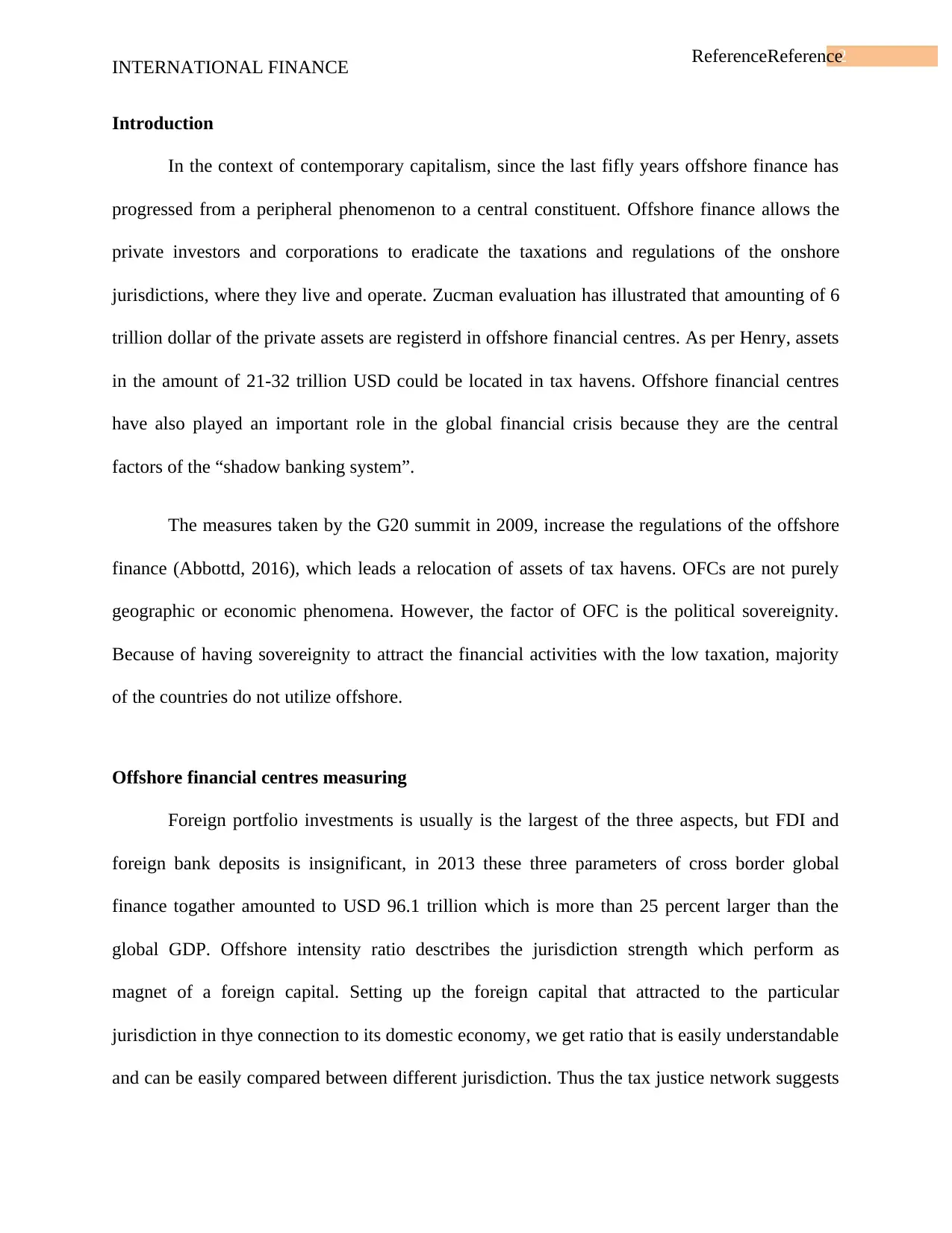
2ReferenceReference
INTERNATIONAL FINANCE
Introduction
In the context of contemporary capitalism, since the last fifly years offshore finance has
progressed from a peripheral phenomenon to a central constituent. Offshore finance allows the
private investors and corporations to eradicate the taxations and regulations of the onshore
jurisdictions, where they live and operate. Zucman evaluation has illustrated that amounting of 6
trillion dollar of the private assets are registerd in offshore financial centres. As per Henry, assets
in the amount of 21-32 trillion USD could be located in tax havens. Offshore financial centres
have also played an important role in the global financial crisis because they are the central
factors of the “shadow banking system”.
The measures taken by the G20 summit in 2009, increase the regulations of the offshore
finance (Abbottd, 2016), which leads a relocation of assets of tax havens. OFCs are not purely
geographic or economic phenomena. However, the factor of OFC is the political sovereignity.
Because of having sovereignity to attract the financial activities with the low taxation, majority
of the countries do not utilize offshore.
Offshore financial centres measuring
Foreign portfolio investments is usually is the largest of the three aspects, but FDI and
foreign bank deposits is insignificant, in 2013 these three parameters of cross border global
finance togather amounted to USD 96.1 trillion which is more than 25 percent larger than the
global GDP. Offshore intensity ratio desctribes the jurisdiction strength which perform as
magnet of a foreign capital. Setting up the foreign capital that attracted to the particular
jurisdiction in thye connection to its domestic economy, we get ratio that is easily understandable
and can be easily compared between different jurisdiction. Thus the tax justice network suggests
INTERNATIONAL FINANCE
Introduction
In the context of contemporary capitalism, since the last fifly years offshore finance has
progressed from a peripheral phenomenon to a central constituent. Offshore finance allows the
private investors and corporations to eradicate the taxations and regulations of the onshore
jurisdictions, where they live and operate. Zucman evaluation has illustrated that amounting of 6
trillion dollar of the private assets are registerd in offshore financial centres. As per Henry, assets
in the amount of 21-32 trillion USD could be located in tax havens. Offshore financial centres
have also played an important role in the global financial crisis because they are the central
factors of the “shadow banking system”.
The measures taken by the G20 summit in 2009, increase the regulations of the offshore
finance (Abbottd, 2016), which leads a relocation of assets of tax havens. OFCs are not purely
geographic or economic phenomena. However, the factor of OFC is the political sovereignity.
Because of having sovereignity to attract the financial activities with the low taxation, majority
of the countries do not utilize offshore.
Offshore financial centres measuring
Foreign portfolio investments is usually is the largest of the three aspects, but FDI and
foreign bank deposits is insignificant, in 2013 these three parameters of cross border global
finance togather amounted to USD 96.1 trillion which is more than 25 percent larger than the
global GDP. Offshore intensity ratio desctribes the jurisdiction strength which perform as
magnet of a foreign capital. Setting up the foreign capital that attracted to the particular
jurisdiction in thye connection to its domestic economy, we get ratio that is easily understandable
and can be easily compared between different jurisdiction. Thus the tax justice network suggests
⊘ This is a preview!⊘
Do you want full access?
Subscribe today to unlock all pages.

Trusted by 1+ million students worldwide
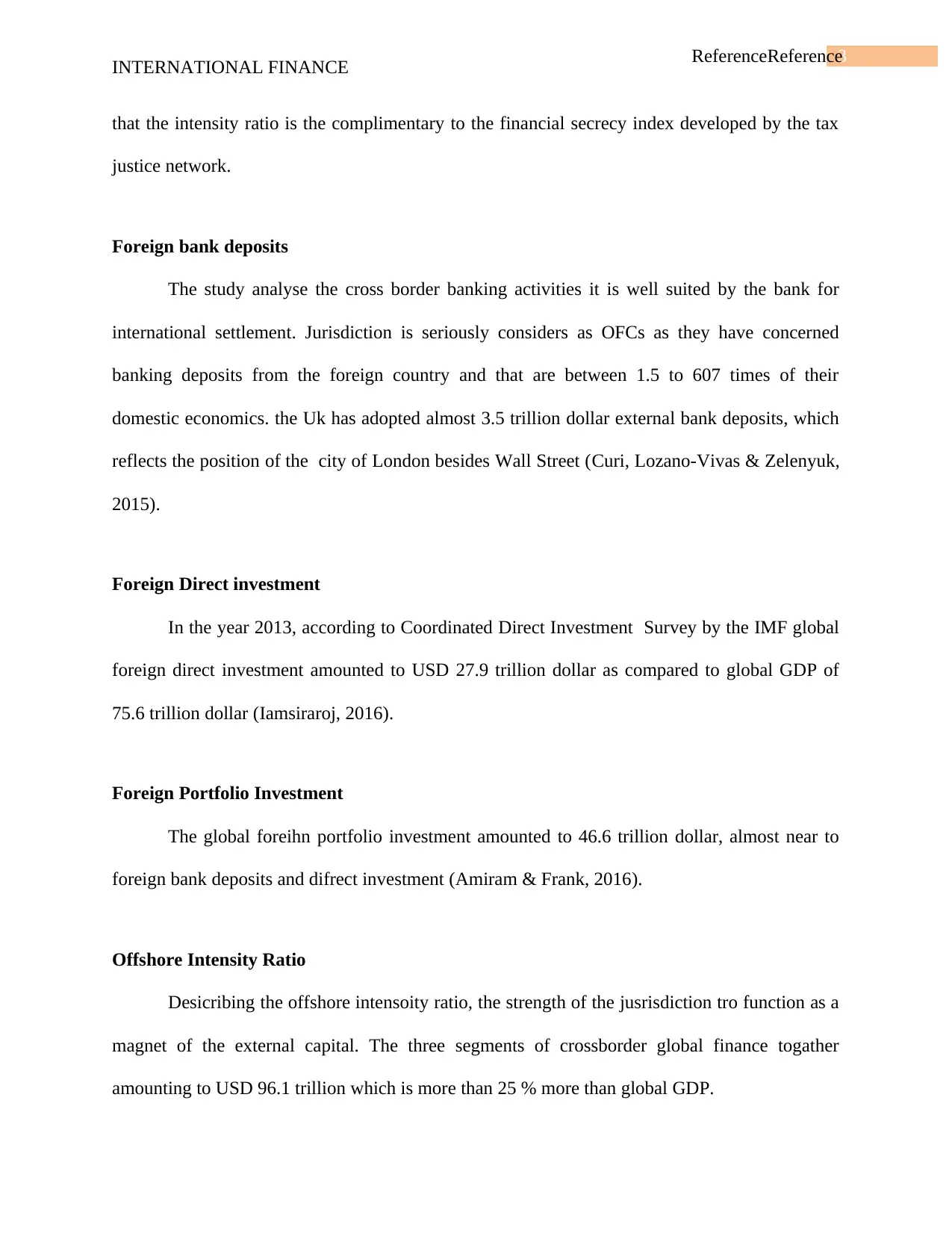
3ReferenceReference
INTERNATIONAL FINANCE
that the intensity ratio is the complimentary to the financial secrecy index developed by the tax
justice network.
Foreign bank deposits
The study analyse the cross border banking activities it is well suited by the bank for
international settlement. Jurisdiction is seriously considers as OFCs as they have concerned
banking deposits from the foreign country and that are between 1.5 to 607 times of their
domestic economics. the Uk has adopted almost 3.5 trillion dollar external bank deposits, which
reflects the position of the city of London besides Wall Street (Curi, Lozano-Vivas & Zelenyuk,
2015).
Foreign Direct investment
In the year 2013, according to Coordinated Direct Investment Survey by the IMF global
foreign direct investment amounted to USD 27.9 trillion dollar as compared to global GDP of
75.6 trillion dollar (Iamsiraroj, 2016).
Foreign Portfolio Investment
The global foreihn portfolio investment amounted to 46.6 trillion dollar, almost near to
foreign bank deposits and difrect investment (Amiram & Frank, 2016).
Offshore Intensity Ratio
Desicribing the offshore intensoity ratio, the strength of the jusrisdiction tro function as a
magnet of the external capital. The three segments of crossborder global finance togather
amounting to USD 96.1 trillion which is more than 25 % more than global GDP.
INTERNATIONAL FINANCE
that the intensity ratio is the complimentary to the financial secrecy index developed by the tax
justice network.
Foreign bank deposits
The study analyse the cross border banking activities it is well suited by the bank for
international settlement. Jurisdiction is seriously considers as OFCs as they have concerned
banking deposits from the foreign country and that are between 1.5 to 607 times of their
domestic economics. the Uk has adopted almost 3.5 trillion dollar external bank deposits, which
reflects the position of the city of London besides Wall Street (Curi, Lozano-Vivas & Zelenyuk,
2015).
Foreign Direct investment
In the year 2013, according to Coordinated Direct Investment Survey by the IMF global
foreign direct investment amounted to USD 27.9 trillion dollar as compared to global GDP of
75.6 trillion dollar (Iamsiraroj, 2016).
Foreign Portfolio Investment
The global foreihn portfolio investment amounted to 46.6 trillion dollar, almost near to
foreign bank deposits and difrect investment (Amiram & Frank, 2016).
Offshore Intensity Ratio
Desicribing the offshore intensoity ratio, the strength of the jusrisdiction tro function as a
magnet of the external capital. The three segments of crossborder global finance togather
amounting to USD 96.1 trillion which is more than 25 % more than global GDP.
Paraphrase This Document
Need a fresh take? Get an instant paraphrase of this document with our AI Paraphraser
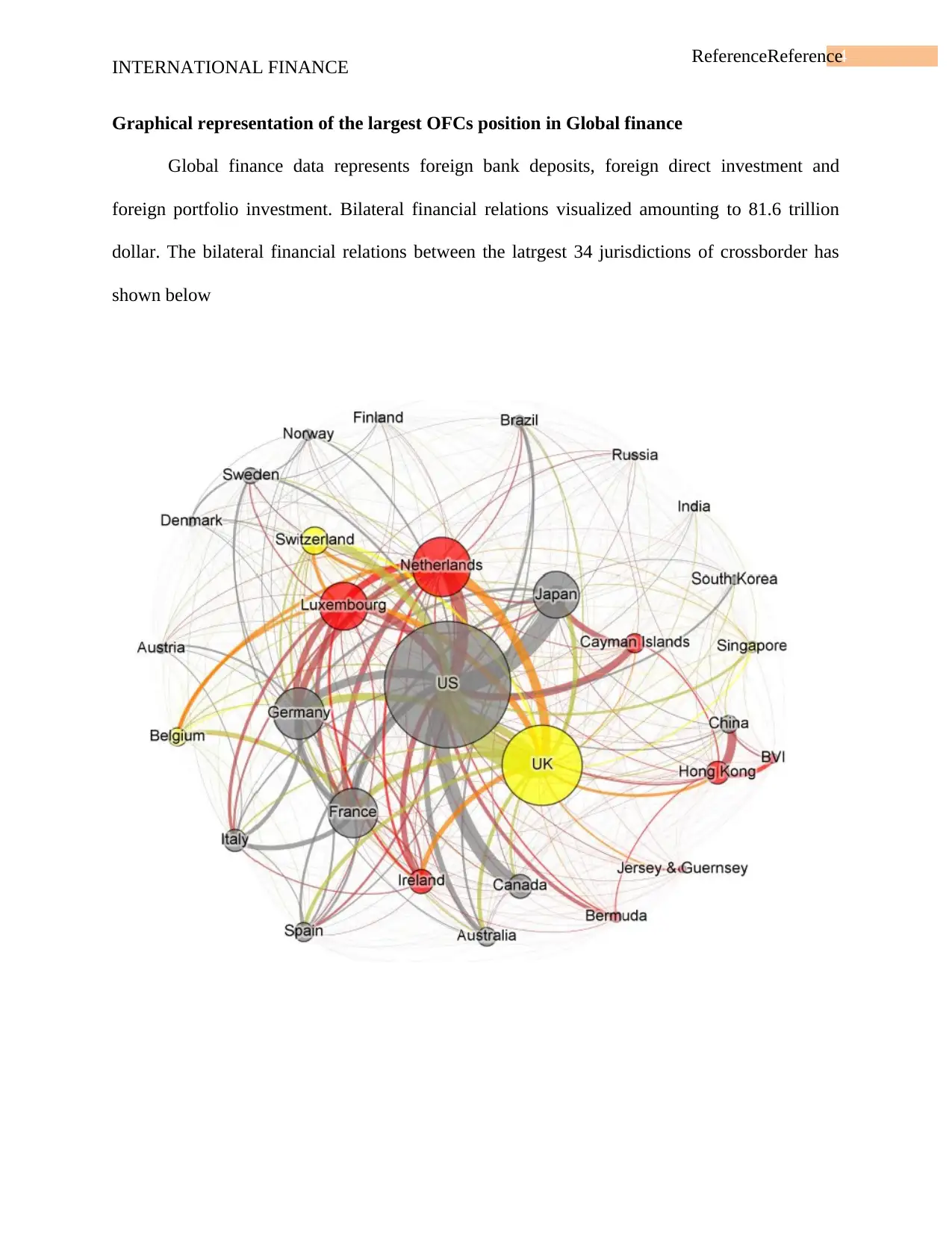
4ReferenceReference
INTERNATIONAL FINANCE
Graphical representation of the largest OFCs position in Global finance
Global finance data represents foreign bank deposits, foreign direct investment and
foreign portfolio investment. Bilateral financial relations visualized amounting to 81.6 trillion
dollar. The bilateral financial relations between the latrgest 34 jurisdictions of crossborder has
shown below
INTERNATIONAL FINANCE
Graphical representation of the largest OFCs position in Global finance
Global finance data represents foreign bank deposits, foreign direct investment and
foreign portfolio investment. Bilateral financial relations visualized amounting to 81.6 trillion
dollar. The bilateral financial relations between the latrgest 34 jurisdictions of crossborder has
shown below

5ReferenceReference
INTERNATIONAL FINANCE
Conclusion
A very straight forward way and simple as well is Offshore intensity ratio to identify
which countries and jurisdiction can be referred as offshore financial centres. The study finds
that a strict regulation of offshore jurisdictions have very significant effect.
INTERNATIONAL FINANCE
Conclusion
A very straight forward way and simple as well is Offshore intensity ratio to identify
which countries and jurisdiction can be referred as offshore financial centres. The study finds
that a strict regulation of offshore jurisdictions have very significant effect.
⊘ This is a preview!⊘
Do you want full access?
Subscribe today to unlock all pages.

Trusted by 1+ million students worldwide
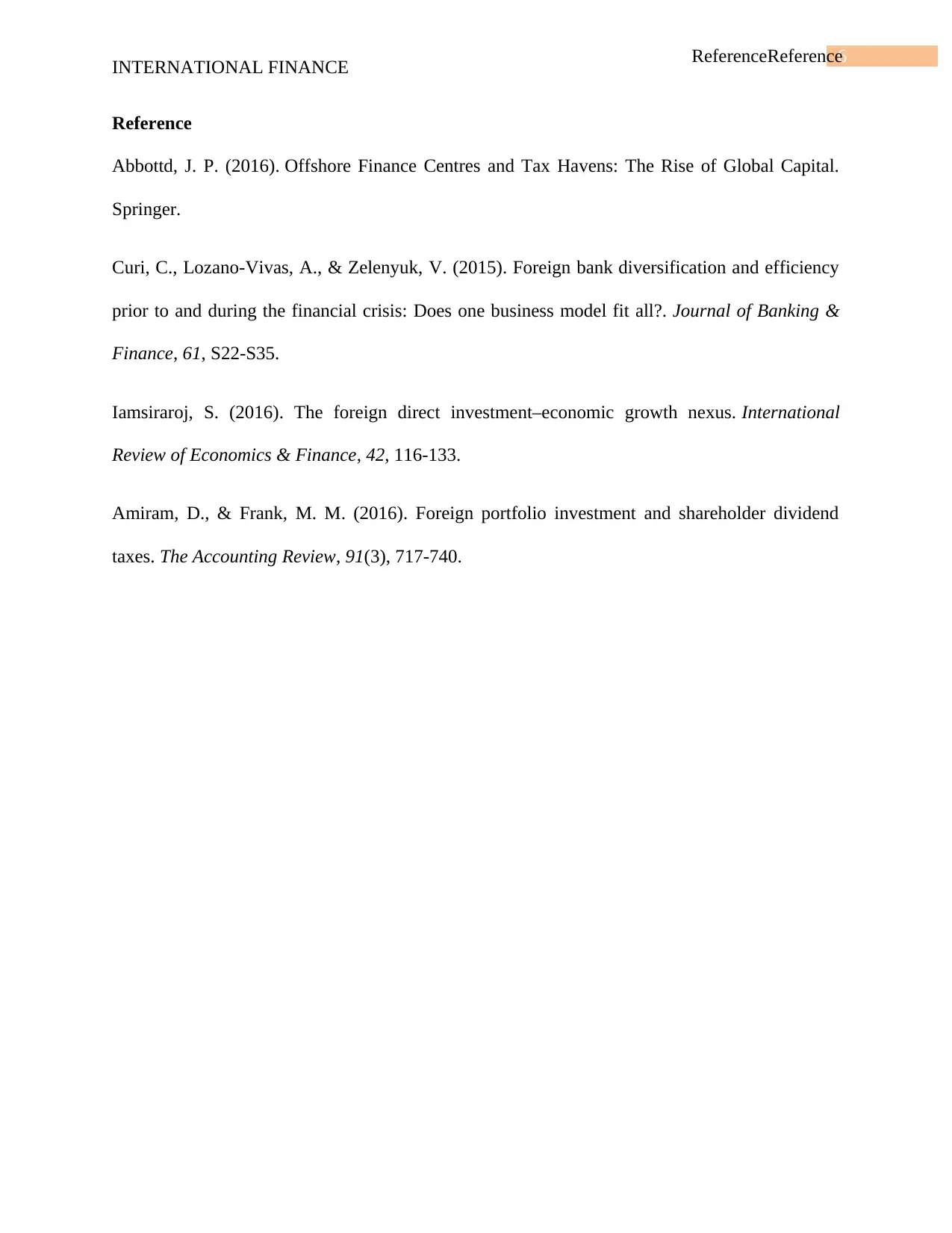
6ReferenceReference
INTERNATIONAL FINANCE
Reference
Abbottd, J. P. (2016). Offshore Finance Centres and Tax Havens: The Rise of Global Capital.
Springer.
Curi, C., Lozano-Vivas, A., & Zelenyuk, V. (2015). Foreign bank diversification and efficiency
prior to and during the financial crisis: Does one business model fit all?. Journal of Banking &
Finance, 61, S22-S35.
Iamsiraroj, S. (2016). The foreign direct investment–economic growth nexus. International
Review of Economics & Finance, 42, 116-133.
Amiram, D., & Frank, M. M. (2016). Foreign portfolio investment and shareholder dividend
taxes. The Accounting Review, 91(3), 717-740.
INTERNATIONAL FINANCE
Reference
Abbottd, J. P. (2016). Offshore Finance Centres and Tax Havens: The Rise of Global Capital.
Springer.
Curi, C., Lozano-Vivas, A., & Zelenyuk, V. (2015). Foreign bank diversification and efficiency
prior to and during the financial crisis: Does one business model fit all?. Journal of Banking &
Finance, 61, S22-S35.
Iamsiraroj, S. (2016). The foreign direct investment–economic growth nexus. International
Review of Economics & Finance, 42, 116-133.
Amiram, D., & Frank, M. M. (2016). Foreign portfolio investment and shareholder dividend
taxes. The Accounting Review, 91(3), 717-740.
1 out of 7
Your All-in-One AI-Powered Toolkit for Academic Success.
+13062052269
info@desklib.com
Available 24*7 on WhatsApp / Email
![[object Object]](/_next/static/media/star-bottom.7253800d.svg)
Unlock your academic potential
Copyright © 2020–2025 A2Z Services. All Rights Reserved. Developed and managed by ZUCOL.


